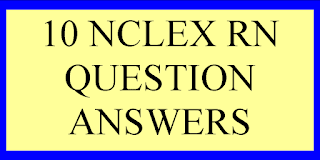1.The client asks the nurse why an electronic health record (EHR) system is being used. Which response by the nurse indicates an understanding of the rationale for an EHR system?
Published by www.nursingwork.in
1) It includes organizational reports of unusual occurrences that are not part of the client's record.
2) This type of system consists of combined documentation and daily care plans.
3) It improves interdisciplinary collaboration that improves efficiency in procedures.
4) This type of system tracks medication administration and usage over 24 hours
Answer: 3) It improves interdisciplinary collaboration that improves efficiency in procedures.
Rationale:
The EHR has several benefits for use, including improving interdisciplinary collaboration and making procedures more accurate and efficient. An occurrence report is an organizational record of an unusual occurrence or accident that is not a part of the client's record. Integrated plans of care (IPOC) are a combined charting and care plan format. A medication administration record (MAR) is used to document medications administered and their usage.
2.A 73-year-old patient who sustained a right hip fracture in a fall requests pain medication from the nurse. Based on his injury, which type of pain is this patient most likely experiencing?
Published by www.nursingwork.in
1) Phantom
2) Visceral
3) Deep somatic
4) Referred
Answer: 3) Deep somatic
Rationale:
Deep somatic pain originates in ligaments, tendons, nerves, blood vessels, and bones. Therefore, a hip fracture causes deep somatic pain. Phantom pain is pain that is perceived to originate from a part that was removed during surgery. Visceral pain is caused by deep internal pain receptors and commonly occurs in the abdominal cavity, cranium, and thorax. Referred pain occurs in an area that is distant to the original site.
Published by www.nursingwork.in
1) It includes organizational reports of unusual occurrences that are not part of the client's record.
2) This type of system consists of combined documentation and daily care plans.
3) It improves interdisciplinary collaboration that improves efficiency in procedures.
4) This type of system tracks medication administration and usage over 24 hours
Answer: 3) It improves interdisciplinary collaboration that improves efficiency in procedures.
Rationale:
The EHR has several benefits for use, including improving interdisciplinary collaboration and making procedures more accurate and efficient. An occurrence report is an organizational record of an unusual occurrence or accident that is not a part of the client's record. Integrated plans of care (IPOC) are a combined charting and care plan format. A medication administration record (MAR) is used to document medications administered and their usage.
2.A 73-year-old patient who sustained a right hip fracture in a fall requests pain medication from the nurse. Based on his injury, which type of pain is this patient most likely experiencing?
Published by www.nursingwork.in
1) Phantom
2) Visceral
3) Deep somatic
4) Referred
Answer: 3) Deep somatic
Rationale:
Deep somatic pain originates in ligaments, tendons, nerves, blood vessels, and bones. Therefore, a hip fracture causes deep somatic pain. Phantom pain is pain that is perceived to originate from a part that was removed during surgery. Visceral pain is caused by deep internal pain receptors and commonly occurs in the abdominal cavity, cranium, and thorax. Referred pain occurs in an area that is distant to the original site.
